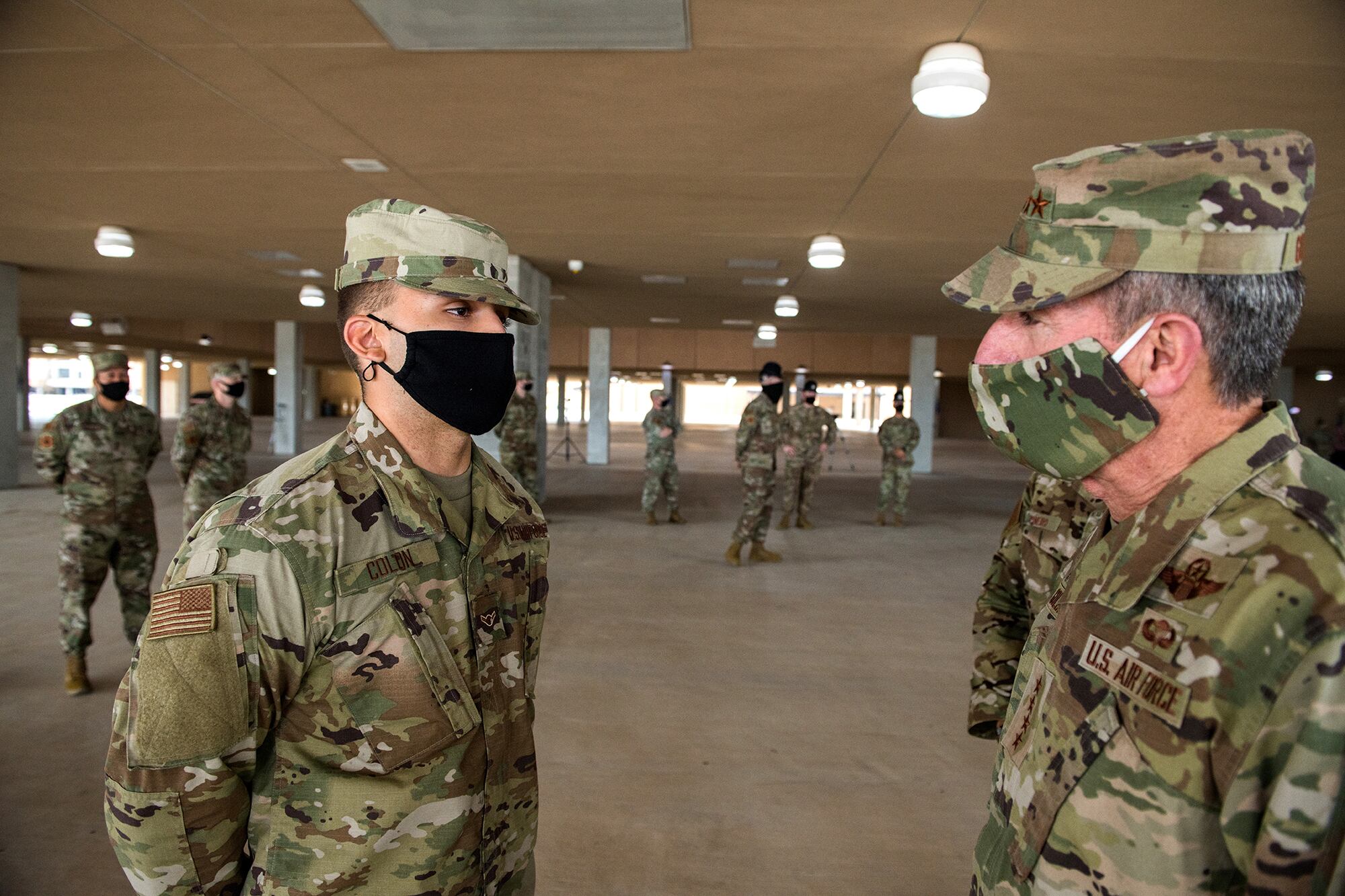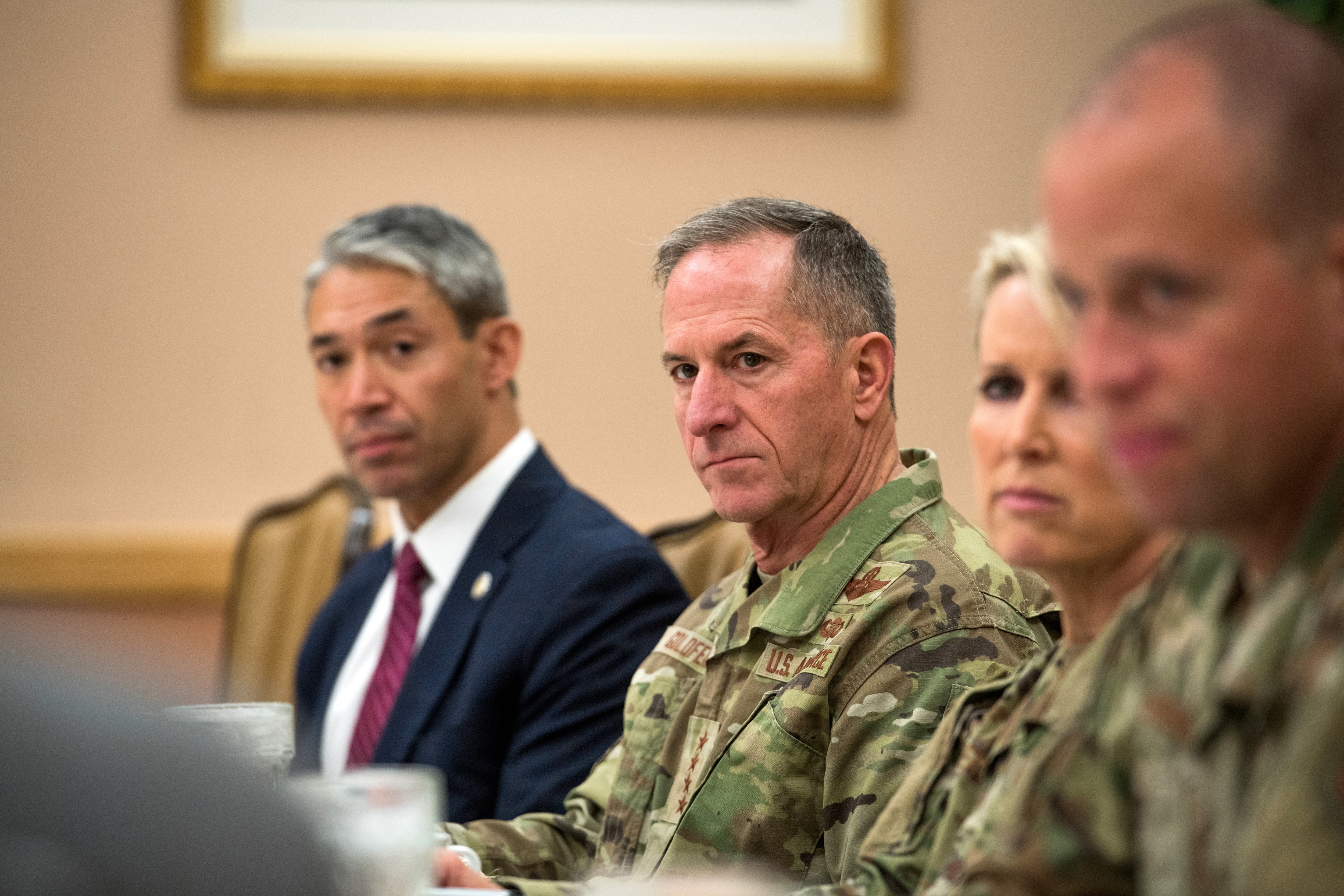Air Force Chief of Staff Gen. Dave Goldfein has led pilots through combat, overseen air operations at war, and even come back safe and sound after being shot down behind enemy lines.
But as he nears retirement this summer after 37 years in uniform, Goldfein faces one of the trickiest challenges of his career: How to prepare the Air Force to operate for months — and probably longer — during a coronavirus pandemic that has snarled every facet of society.
“How do you change the way you’re doing business to be able to continue to operate with a cyclical virus in our midst?” Goldfein said in an exclusive interview with Air Force Times. “We have to expect, [and] the scientists tell us, [the virus] will return a few times before we get a vaccine.”
By the end of this summer, the Air Force will have gone through three “resets” as it adjusts to the coronavirus, Goldfein said during a phone conversation Tuesday. The first reset came in April, and focused on how to ensure its most critical missions — nuclear operations, cyber, space, intelligence, surveillance and reconnaissance, and homeland defense — continue.
“We reset our operations across the Air Force to build breadth and depth across these critical mission sets,” Goldfein said.
The second reset is expected to come June 30, Goldfein said. It seeks to figure out how to get its training pipeline in better shape. Some changes had to be made in basic military training, undergraduate pilot training, and other forms of technical training where airmen learn to be maintainers, air traffic controllers or air battle managers, Goldfein said. But now, the Air Force needs to figure out how to make training work in this environment for the long haul.
“We changed the way we are doing business, but we have certain areas where we’re operating at about 50 percent, and that is not sustainable,” Goldfein said.
It’s not realistic to expect those training areas to get back up to full capacity, he said, but he’s hoping to find a way to get to at least 75 percent to be sustainable until a vaccine is widely available. What’s more, Goldfein said, the Air Force is seeing retention improve recently as more airmen choose to stay on longer. The combination of increased retention and getting training back to 75 percent capacity should be enough to meet the Air Force’s needs, he said.
Bracing for autumn
The third and final reset, which Goldfein set for Aug. 1, seeks to prepare the Air Force for what will likely be a “turbulent fall," he said. Several complicating factors could converge at that time.
Not only is the coronavirus expected to resurge as temperatures start dropping, Goldfein said, the regular flu season is also expected to be a bad one. That will be particularly complicated, he said, since people who contract the regular flu may think they have the coronavirus.
What’s more, meteorologists are predicting this year’s hurricane season will be worse than average — possibly much worse. Last month, respected meteorologists from Colorado State University specializing in hurricanes predicted 16 named tropical storms will form this year. Of those, eight could become hurricanes, and this season could see four major hurricanes. A typical season, which runs from June 1 to Nov. 30, sees 12 tropical storms, six of which become hurricanes.
And to top it off, the election season this fall will bring additional responsibilities for the Air Force, Goldfein said. As President Trump increases his travel during the campaign, that means more travel on Air Force One.
“The August reset is, how do we position the Air Force so we’re postured accordingly, to be able to handle what could be a pretty turbulent fall,” Goldfein said.

Goldfein said that Hurricane Michael’s 2018 devastation of Tyndall Air Force Base showed how important it is to prepare for extreme weather, like any other adversary that is violent and appears with little warning. Lessons learned after Michael, including how to posture vulnerable bases and when to fly out aircraft when weather threatens, will be ready for this hurricane season, Goldfein said.
And to get training capacity back to around 75 percent, Goldfein said the Air Force is giving lower-echelon commanders, down to the squadron level, more authority.
RELATED

In an April 28 memo, Goldfein asked commanders to dust off old Ability to Survive and Operate manuals — guides that spell out how the Air Force could operate in environments contaminated by radiation or chemical weapons — and find inspiration for creative ways to get the job done during coronavirus.
One thing Goldfein won’t do is start sending his own ideas down to commanders on the ground.
“As soon as I start talking about ‘how,’ I will unintentionally crush creativity where I need it most, which is at that squadron, group and wing level," Goldfein said.
Goldfein said many retirees with this kind of experience have also contacted the Air Force to share their ideas for how to operate during the coronavirus.
The equipment used to deal with chemical, biological and radiological contaminants is different than the personal protective equipment for the coronavirus, Goldfein said. But the basic principles of how to decontaminate an aircraft, or how to separate a contaminated base into “clean” or “dirty” areas are very similar, he said.
“There are principles that we developed over the years that can be applied creatively to this scenario, to allow us to get our production numbers up and operate in this new normal in a way that is sustainable,” Goldfein said. “I do think that, if we can allow the creativity to come from the right levels of command and leadership, I’m very confident that we’ll be able to get up to the numbers I’m looking for.”
These changes are important to start working on now, because the coronavirus probably isn’t going away anytime soon. And it remains unclear when a vaccine will be available. Defense Secretary Mark Esper said on Friday that a vaccine would be available by the end of the year, but a Pentagon memo said that the vaccine might not be available until next summer. In his April 28 memo to commanders, Goldfein warned that a vaccine to protect against COVID-19 could be 18 months away.
The Air Force has so far recorded 453 positive cases of COVID-19, the disease caused by the coronavirus, among uniformed airmen. That’s the lowest per capita rate of all the military services.
Goldfein said he believes the Air Force’s comparably lower rate is because airmen tend to be more spread out on the job. For example, airmen on a flightline can usually get their jobs done several feet away from one another.
Air Force bases also tend to be larger and more spread out, Goldfein said, and are often located in rural or sparsely-populated areas with plenty of open airspace and fewer residents to disturb with aircraft noise. Those factors also could help reduce infection rates in the Air Force.
“If you look at what we know about the virus and what we know works in terms of [preventing] transmission, we know physical distancing works, we know masks work, we know proper hygiene protocol works,” as well as isolating people who start to display symptoms, Goldfein said. “If you follow those four protocols, then you’re going to be very successful."
Goldfein said he’s comfortable with the amount of testing the Air Force does, given the need to prioritize testing kits for older and more vulnerable population centers such as nursing homes.
Passing the torch
But while the coronavirus remains a pressing day-to-day crisis, Goldfein is also still working to finalize some of his top priorities before he retires — revitalizing the Air Force’s squadron structure, improve joint leader development, and multi-domain command and control. The exact date of his retirement has not yet been set.
As he looks back on his tenure as chief, Goldfein said that the effort to improve squadrons — the “foundational fighting formation” of the Air Force, as he puts it — and give commanders more authority is bearing fruit.
“If I hear one thing when I travel more than anything else, it’s how much fun squadron command is, and how much they’re able to do with the squadron innovation funds and the delegation of authority,” Goldfein said. “I’m proud of the Air Force for what we’ve been able to accomplish with that.”
But while the Air Force has made progress on each those three efforts, Goldfein said, they’re not done, and work will continue for years.
“The things you pick [to work on] as chief ought to be really hard, to be worthy of a chief’s time,” Goldfein said. “They don’t actually result in planting a flag on top of a hill. They’re a journey, versus a destination. And I don’t honestly believe the journey ever ends. We still have miles to go.”
Goldfein will likely be succeeded by Gen. Charles Q. “CQ” Brown, the current commander of Pacific Air Forces. Goldfein and Brown have known each other nearly their entire careers and worked with each other several times, such as in 2013 when Brown was the deputy combined force air component commander for U.S. Central Command and Goldfein was commander of U.S. Air Forces Central Command.
Trump nominated Brown in March, and the Senate Armed Services Committee held his nomination hearing on May 7. Brown is expected to be confirmed by the Senate.
Goldfein said Brown is an experienced combat leader, who has built relationships with officials across the Pacific, Middle East and African regions and NATO.
“You don’t have a person who is more connected and is more combat-savvy than CQ Brown,” Goldfein said. “No one’s been better prepared for this job than him. It’s going to be exciting to watch our Air Force just flourish under his leadership.”
Stephen Losey is the air warfare reporter for Defense News. He previously covered leadership and personnel issues at Air Force Times, and the Pentagon, special operations and air warfare at Military.com. He has traveled to the Middle East to cover U.S. Air Force operations.




